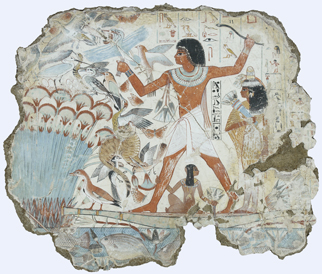4 Hunting in the marshes
In this section you will look at the fragment ‘Hunting in the marshes’ (Figure 19).
This painting has achieved iconic status. It is likely to be illustrated in any survey of the history of Egyptian art, or indeed to illustrate ancient Egypt in any survey of ‘world art’.

Why do you think it has achieved such prominence? What do you think it shows?
This painting is very attractive to modern eyes. It is quite brightly coloured, the forms are clear, there is a lot of incident for the eye to fix on, and it now has an air of the exotic that will appeal to someone’s sense of being adventurous and open-minded about art. It contains recognisable figures, yet manages to be wholly non-academic, provides a bit of a puzzle about what exactly is going on, yet doesn’t suffer from the obscurity many people associate with contemporary ‘conceptual art’.
This set of responses is closely bound up with what the work appears to be about because it seems, at first sight, as if it shows the good life; a handsome man with a beautiful wife and a child, engaged in sporting activity in a warm climate, almost as if they were on a family holiday. There is something very powerful about this conjunction of the manifestly ancient with the apparently modern, as if time and space can be collapsed, and everyone, everywhere, has always been a bit like ‘us’.
